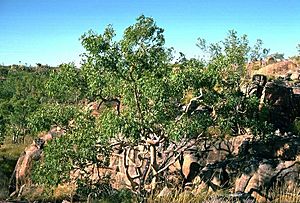Kalumburu gum facts for kids
Quick facts for kids Kalumburu gum |
|
|---|---|
 |
|
| Eucalyptus herbertiana at Katherine Gorge, Northern Territory | |
| Scientific classification | |
| Genus: |
Eucalyptus
|
| Species: |
herbertiana
|
The Kalumburu gum, also known as Eucalyptus herbertiana or yellow-barked mallee, is a special type of tree or large bush. It grows only in northern Australia. This plant has smooth bark and leaves shaped like a spear or a curve. Its flowers are white, and they grow in groups of seven. After flowering, it produces fruit that looks like a small cup, half a sphere, or a cone.
What it Looks Like
The Kalumburu gum is usually a small tree or a mallee. A mallee is a type of eucalyptus that has many stems growing from a large woody base underground. This plant typically grows to be about 4 to 10 metres (13 to 33 ft) tall. It has a special woody swelling at its base called a lignotuber. This helps the plant regrow after fires.
Its bark is smooth and powdery white. When new bark grows, it can be salmon pink or creamy yellow. Young plants have bluish-grey leaves that are shaped like an egg. These leaves are about 70–100 mm (2.8–3.9 in) long and 35–65 mm (1.4–2.6 in) wide. The adult leaves are dull green on both sides. They are shaped like a spear or are slightly curved. These leaves are 80–220 mm (3.1–8.7 in) long and 10–22 mm (0.39–0.87 in) wide. They grow on a leaf stalk called a petiole, which is 10–30 mm (0.39–1.18 in) long.
Flowers and Fruit
The flower buds of the Kalumburu gum grow in groups of seven. They are found where the leaves meet the stem. Each group of buds grows on a stalk called a peduncle, which is 3–14 mm (0.12–0.55 in) long. Some buds are directly attached (sessile), while others have small stalks called pedicels that are 1–5 mm (0.039–0.197 in) long.
When the buds are ready to open, they are oval-shaped. They are about 4–8 mm (0.16–0.31 in) long and 2.5–4 mm (0.098–0.157 in) wide. Each bud has a cone-shaped cap called an operculum. The plant usually flowers in January, from June to July, or from November to December. Its flowers are white or creamy white.
After the flowers, the plant produces woody fruits. These fruits are like small cups, half-spheres, or cones. They are about 2.5–5 mm (0.098–0.197 in) long and 4–6 mm (0.16–0.24 in) wide. The parts that release the seeds stick out high above the rim of the fruit. In the Northern Territory, this eucalyptus tree loses its leaves during the dry season.
How it was Named
The Eucalyptus herbertiana was first officially described by a botanist named Joseph Maiden in 1923. He wrote about it in his book called A Critical Revision of the Genus Eucalyptus. The plant was named after another Australian botanist, Desmond Herbert.
The Kalumburu gum is part of a small group of eucalyptus species that are related to the "red gums." It is most similar to E. cupularis and E. gregoriensis. It also looks a bit like the mountain white gum (E. mooreana). However, E. mooreana has leaves that wrap around its stem, which is different from the Kalumburu gum.
Where it Grows
The Kalumburu gum is found in northern Australia. It grows in the Kimberley region of Western Australia, the top end of the Northern Territory, and into western Queensland. You can often find it growing in thin soils among sandstone rocks, on hillsides, and at the bottom of ridges.
Conservation Status
Good news! The Kalumburu gum is not considered to be in danger. The Western Australian Government's Department of Parks and Wildlife says it is "not threatened." The Northern Territory Government also lists it as "least concern" under their Territory Parks and Wildlife Conservation Act 2000. The Queensland Government agrees, listing it as "least concern" under their Nature Conservation Act 1992. This means there are plenty of these plants, and they are not at risk of disappearing.

